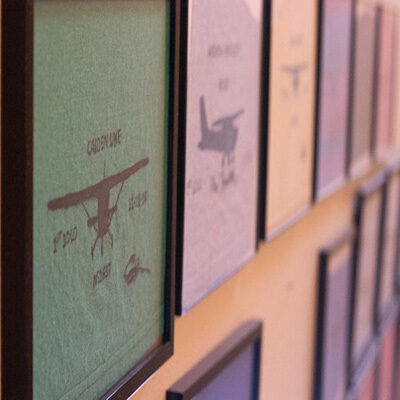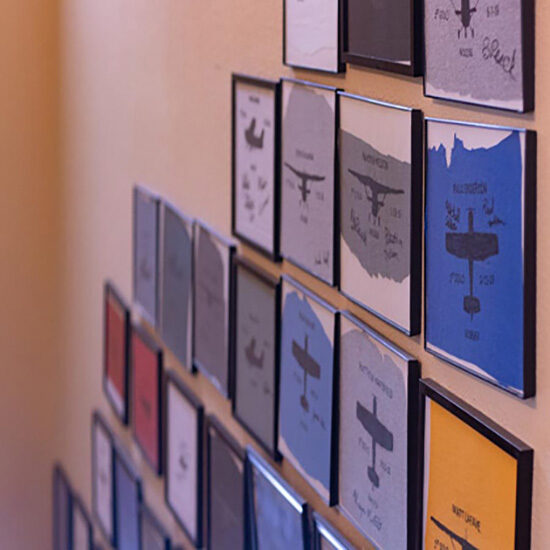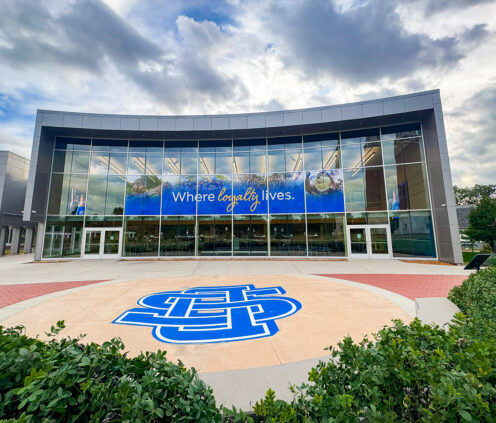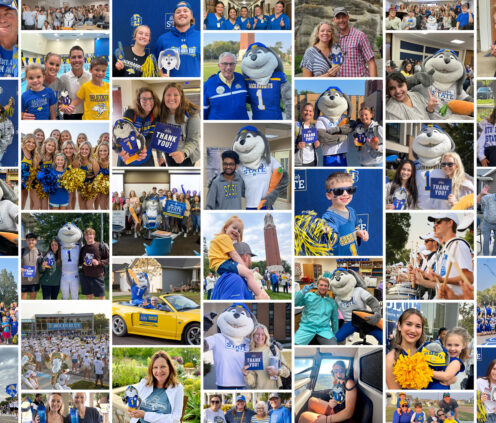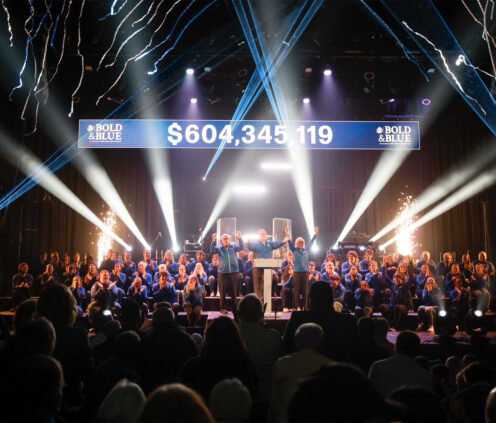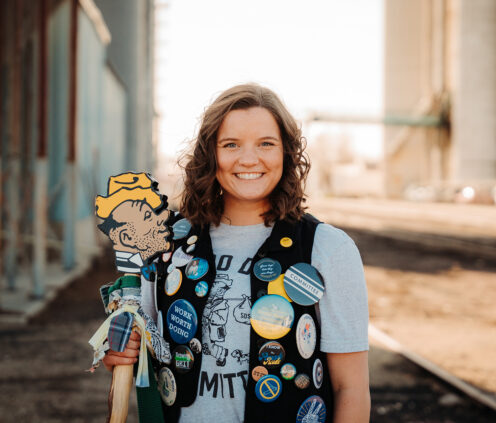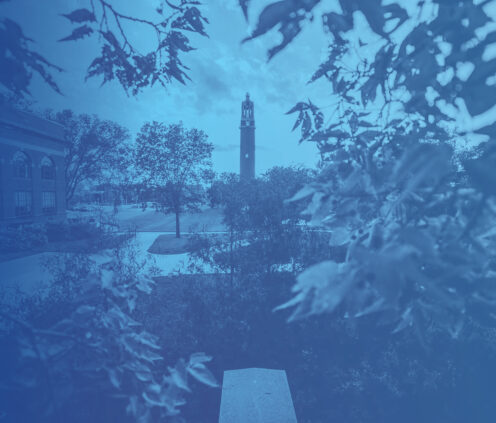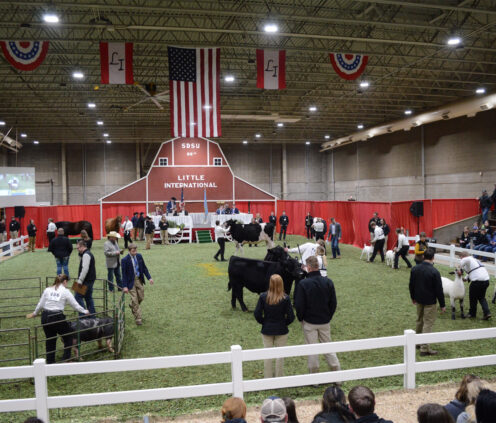Solo Flights Pilot a Unique Jackrabbit Tradition
An interesting rite of passage awaits each Jackrabbit pilot following their first solo flight.
Scroll
A curious sight awaits visitors to the SDSU Aviation Facility. Along the building’s staircase hangs a cluster of picture frames, each one home to a different swatch of fabric.
Various patterns, colors, and materials occupy the wall, each one representing a student pursuing a degree in aviation. Though origins of the program trace back to the 1930s, the aviation degree wasn’t formally established at SDSU until 1998. In that time, Jackrabbit pilots have created a time-honored tradition that involves shirttails. Yes, you read that right: shirttails.
In the early days of in-flight training, flight instructors would sit directly behind the student pilot in the plane. In that time, technology didn’t allow for much communication between teacher and pupil. With no headset or microphone system yet invented, flight instructors tugged on the student’s shirt to get their attention and offer assistance. As a rite of passage after each Jackrabbit’s first solo flight, they’re invited to pay homage to that tradition by cutting off their shirttail and hanging it on the wall. With their degree in hand, Jackrabbits are ready to fly solo, no longer in need of that tug of support.
After learning of that unique tradition, we had countless questions – and we sat down with Aviation Trainer Jacob Fouberg to learn more: how the tradition began, what makes the SDSU aviation program a premier destination for flight, and what we can expect from the program in the future.
Tell us more about the shirttail-cutting tradition. How does it relate to both instructors and students?
"Early training aircraft, such as the Piper Cub, had tandem seating where the flight instructor would sit in the back and the student would sit in the front. Additionally, these airplanes were open-cockpit and hearing was difficult. Instead, instructors would improvise and often tug on the back of a pilot's shirttail to get their attention.
Flight instructors guide and work closely with their students and take them under their wing to share their expertise and passion for aviation. It would only be appropriate for the instructor to cut their student’s shirttail and sign it."
What inspired the shirttail-cutting practice within the Jackrabbit aviation program?
"This is an important event for every pilot's career and a great way to recognize a student's hard work and accomplishments. While there are other traditions out there, I would say this is the most common. After a student's first solo flight is made at SDSU, the instructor signs and dates the swatch. It is then framed and put on the wall leading up the stairs, along with others from pilots who have went before them.
Today, we still have alumni coming back to visit, and they will often take their first solo shirttail with them if they did not when they left the school. It's a simple tradition that will have a lifetime impact on the pilot and the memory of where it all started."
What makes the SDSU aviation program unique?
"What makes SDSU's aviation program unique is our people. We have an outstanding maintenance team that always ensures that our airplanes are safe and ready to fly. Our administrative and flight operations/management staff alleviate all the headwork so that flight instructors and students can focus on flying and learning. Additionally, our on-campus faculty are knowledgeable and experienced pilots. They helped me learn so much when I was a student at SDSU, but they would also take the time to help you with things that maybe were not school related. They are people who care about your wellbeing.
To be a little more specific of what separates us, I would say it's our culture, education, and our value. I'm from small-town South Dakota, and I graduated with a class of 10 people in my high school. If you want to pursue an education that is close-knit and feels like family, this is the place.
And finally, our program is a good value: as an FAA Part 141, students often can go on to the airlines with 1,000 flight hours, compared to 1,500 hours, saving them a significant amount of money and training time."
What goals do you envision for the program in the future?
"I would like to see the program continue to grow in numbers, success, and awareness. When enrolled at SDSU, I originally intended to study pre-law and political science. At the time, I had never even considered aviation as a career or even knew SDSU had a program. After riding along with a friend who was in the program, I fell in love with it and switched majors. I want everyone to have the chance to fly, and SDSU allows people to do that by being affordable and a top-notch program."
How has the aviation program evolved during your time instructing at SDSU?
"Like every entity, change is inevitable. SDSU Aviation continues to evolve for the better. While I have only been instructing for a year, we have continued to grow in students, airplanes, and faculty. The aviation program has grown to 180 students enrolled. Students flew over 7,200 hours in 2021 with the program’s 17 aircraft."
What is your favorite thing about instructing for aviation?
"There are so many moments during instruction where I can't believe I get to do this for a living: flying early mornings and watching the sunrise, or during the evening and watching the sunset, is such a surreal and peaceful moment. Flying cross-country and going to different airports is a difference experience every time. I would say my favorite and most rewarding experience is when I watch a student solo or pass a check ride and earn a certificate. There is so much preparation that goes into it, and it makes me incredibly happy for them when they do well."
SDSU’s aviation program is the first and only program established in the state. As one of the fastest growing majors, it’s home to graduates who will go on to not only meet the demand for commercial pilots, but also lend their talents and training to much needed air services in rural and agricultural roles. While competitive compared to other institutions offering aviation, the program is also among the university’s most expensive: the total estimated average cost of the SDSU Aviation program for each student is $86,325. Scholarship support, as well as gifts to the Alan O. Tuntland Hangar, help to alleviate costs and ensure that every Jackrabbit who has a dream to fly can soar unencumbered and someday hang their shirttail among the many others who call SDSU home.

